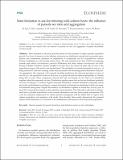Mate limitation in sea lice infesting wild salmon hosts : the influence of parasite sex ratio and aggregation
Abstract
Mate limitation in dioecious parasite species has the potential to impact parasite population growth. Our focus of interest was the influence of parasite sex distribution amongst hosts on parasite reproduction, and transmission dynamics for populations of ectoparasitic sea lice (Lepeophtheirus salmonis Krøyer) establishing on wild juvenile salmon hosts. The data included more than 139,000 out-migrating juvenile pink salmon (Oncorhynchus gorbuscha (Walbaum)) and chum salmon (O. keta (Walbaum)) in British Columbia, Canada, sampled over nine years. For almost all years, the sex ratio of the reproductive stages of the sea lice was female-biased. The probability of a female being able to mate (i.e. of being attached to a fish also carrying a male louse) increased with increasing parasite abundance and parasite aggregation. We compared, with expected modelling predictions, the observed prevalence of pairs of sea lice (i.e. one reproductive louse of each sex) on a given fish, and the observed probability of a female being able to mate. These comparisons showed that male and female sea lice tend to be distributed ‘together’ rather than ‘separately’ on hosts. Distribution ‘together’ means that sea lice are distributed randomly on hosts according to a common negative binomial distribution, whereas distribution ‘separately’ means that males are distributed according to a negative 30 binomial and females are distributed in their own negative binomial among hosts. Despite the tendency for ‘distribution together’ we found that, in every year, at least 30% of reproductive female sea lice experience mate limitation. This Allee effect will result in sub-maximal rates of parasite reproduction at low parasite abundances and may limit parasite transmission. The work has important implications for salmon parasite management and the health both of captive farm salmon populations and migratory wild stocks. More broadly, these results demonstrate the potential impact of mate limitation as a constraint to the establishment and spread of wild ectoparasite populations.
Citation
Cox , R , Groner , M , Todd , C D , Gettinby , G , Patanasatienkul , P & Revie , C 2017 , ' Mate limitation in sea lice infesting wild salmon hosts : the influence of parasite sex ratio and aggregation ' , Ecosphere , vol. 8 , no. 12 , e02040 . https://doi.org/10.1002/ecs2.2040
Publication
Ecosphere
Status
Peer reviewed
ISSN
2150-8925Type
Journal article
Description
Research was undertaken thanks to funding from the SALMODIS project and the Canada Excellence Research Chairs Program. In particular, the CERC Aquatic Epidemiology Visiting Scientist initiative provided support for an extended visit by C.D.T. to work with colleagues at UPEI.Collections
Items in the St Andrews Research Repository are protected by copyright, with all rights reserved, unless otherwise indicated.

